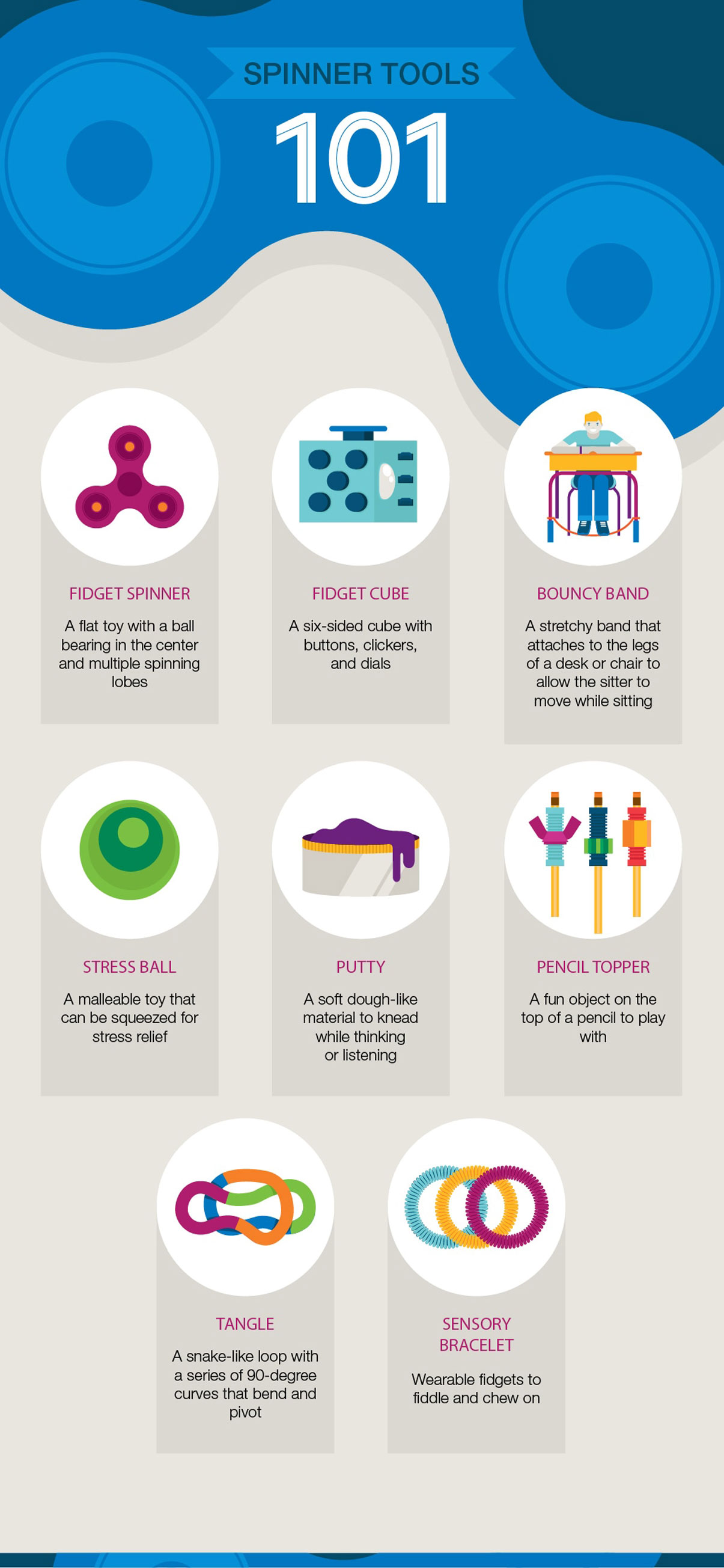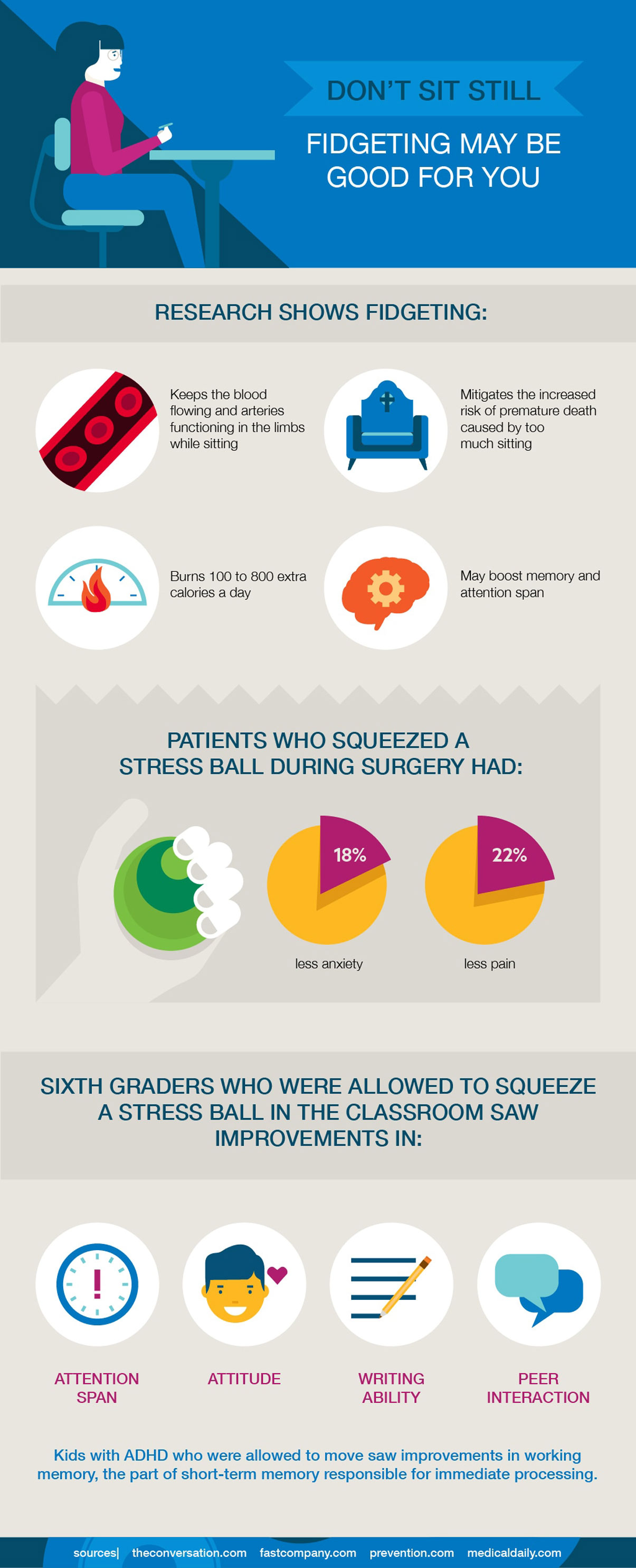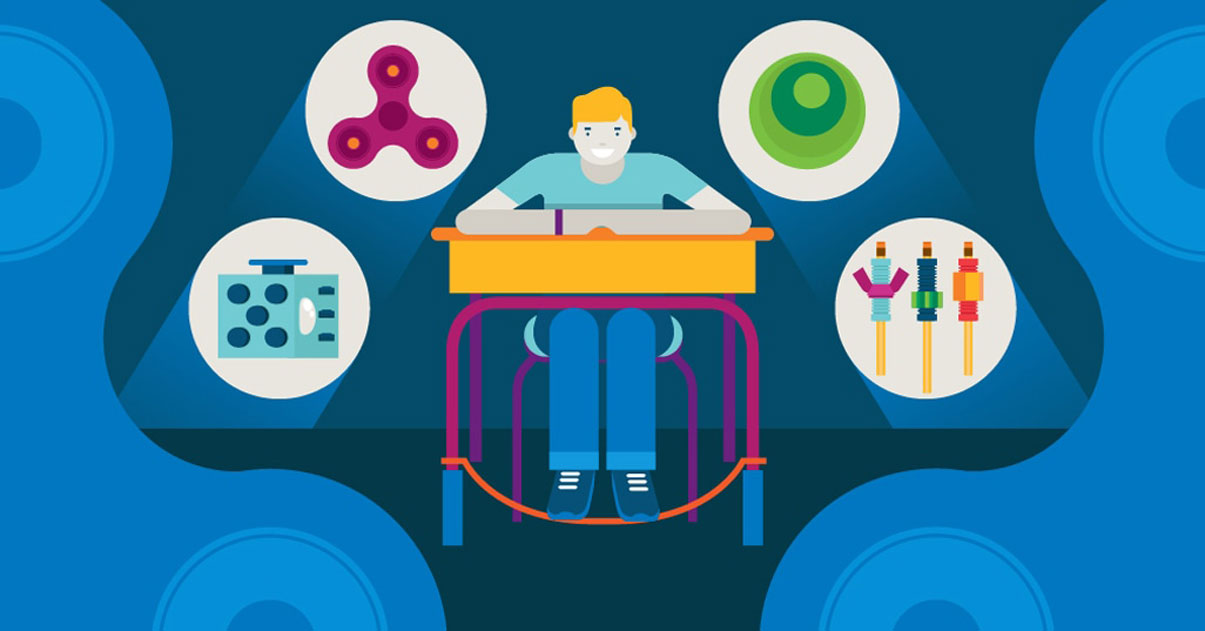If you've been around a school-aged child during the past year, you've seen a fidget spinner. The whirling, spinning, flashing toys burst onto the scene in the spring of 2017, and kids across the nation quickly became spinner-obsessed. (Not all teachers and principals are as fond of them though, and they've been banned in many schools because they can be distracting.)
However, it's too soon to throw fidget toys out of classrooms. Not only do kids love them, but research suggests they can help some kids manage anxiety and improve concentration. Keep reading to learn about the benefits of using fidget toys in the classroom, and how to ensure they support learning instead of becoming a distraction.

Fidget Spinners for Anxiety
Fidget spinners get a bad rap for serving as a distraction, but they may calm kids with higher-than-average anxiety. About one in eight kids have an anxiety disorder, defined as chronic fear and nervousness that interfere with daily life. Anxiety disorders are often triggered by stressful events, such as starting school, moving, or losing a loved one. Nervous habits are common even for kids without anxiety disorders. About half of kids bite their nails because of stress, boredom, or frustration, and some kids twirl their hair or suck and chew on pens or items of clothing.
Occupational therapists have long advocated for the use of fidget and sensory tools to help kids with anxiety or sensory disorders regulate and quiet their nervous systems. Research and anecdotal evidence suggest sensory toys help some people expend energy and quickly calm down. In one study, patients who squeezed a stress ball during surgery reported 18 percent less anxiety and 22 percent less pain. Squeezing a stress ball has also been shown to relieve anxiety during cancer treatments.
The reason some people calm down while using fidget toys is because of the way their brains and nervous systems integrate and process sensory input. Some people need extra sensory input to keep their brains alert and organized. Manipulating a fidget toy allows their brains to filter out other distracting sensory input in the environment or body, which helps them feel calmer.
Fidget Toys for Better Concentration
Fidget tools may also help many kids concentrate better. In one study, a class of sixth graders used stress balls for seven weeks. Researchers found that the kids’ attention spans increased and their attitude, writing abilities, and peer interaction improved. In another study, six- to eight-year-olds could answer more questions correctly when they were allowed to use their hands than when they were forced to keep their hands still.

Fidget Toys in the Classroom
Far from something negative, fidgeting may be kids’ way to cope with our modern sedentary lifestyle, which restricts healthy movement. Our bodies are not designed to be still for long periods, and sitting too much has been implicated in a range of modern health epidemics, including obesity, diabetes, and cardiovascular disease. In past eras, children were outside moving and playing freely from dawn until dusk. Today, elementary-aged kids sit for approximately 8.5 hours a day and spend less time in self-directed learning tasks where they're able to move freely than kids did even 20 years ago.
Many of the behavior problems teachers manage in classrooms may be prevented by allowing more movement. Teacher Jennifer Merriman outfitted her students’ chairs with fidget bands and reported immediate improvements in her students’ performance and behavior.
Children who wiggle or get up frequently to use the bathroom or sharpen a pencil are responding to the body's natural and healthy need to move, but it may keep them from paying attention to a lesson. Fidget toys help students focus and listen but allow them to move. However, these only work when the students and the fidget toys don't distract other students.
Many teachers have successfully introduced fidget toys into classroom learning. Fidget spinners tend to be one of the more distracting options, but this hasn't stopped some teachers from embracing them. Science, technology, engineering, and math (STEM) teachers have tapped into the spinning craze by assigning their students to make fidget spinners. Other teachers integrate fidget spinners into classroom lessons.

Some teachers find fidget spinners too distracting for regular class time and only allow them during recess, free time, or special lessons. During classroom lessons, teachers allow students to use more discrete fidget toys. Fidget cubes, bouncy bands for chairs, stress balls, and putty may be good options. As a fun classroom project, students can make their own DIY bouncy bands for chairs using nine-inch pieces of PVC pipe and recycled bicycle tubes.
To ensure fidget toys don't become distractions, it's helpful to establish clear rules for use in the classroom. That way kids know exactly what kind of behavior you expect. Consider the following guidelines:
- Students may use a fidget toy when they have a hard time calming down or paying attention to the teacher.
- Students may hold the fidget toy, move it, and play with it as long as they look at and listen to the teacher.
- The fidget toy must stay in students’ hands or on their desks.
- Students may not use fidget toys to try to get the attention of friends.
- If a fidget toy is distracting to the teacher or other students, the student will need to find a different fidgeting strategy.
- When students are done with fidget toys, they need to put them away.
Tools, Not Toys
It may be time to rebrand fidget toys as classroom tools. Yes, fidget spinners can be distracting, but fidgeting helps calm many kids and makes it easier for some to concentrate. Moreover, integrating popular fidget props into classroom lessons can get kids excited about learning.
Share this infographic on your site
Abby Quillen
Abby Quillen is the author of the novel The Garden of Dead Dreams and the editor of two anthologies. Her articles and essays have appeared in YES! Magazine and The Christian Science Monitor and on Common Dreams, Nation of Change, Reader Supported News, The Daily Good, Truthout, and Shareable. She lives in Eugene, Oregon, with her family. When she's not writing, she grows vegetables and weeds, bikes and walks as much as she can, and jots down cute things her kids say. Visit her at abbyquillen.com.


